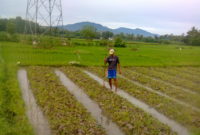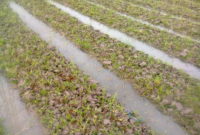Contour-furrow irrigation can save irrigation water, reduce erosion, and mean better crops on sloping fields. You waste little water by surface runoff or by over irrigation at the upper end of the furrows. In comparison with down -slope irrigation, water in contour furrows moves more slowly across the field and, therefore, does not erode or wash the soil. You get a more even distribution of water over the field, making good growing conditions for all of the plants. This pays off in better yields and in higher quality products. Irrigation water flowing down sloping fields is wasting our basic soil and water resources at a very serious rate. Contour-furrow irrigation can be a deciding factor in maintaining our agricultural production and our standard of living.

The Pros/Benefits/Advantages of Contour- Furrow Irrigation:
1. Reduces the erosion hazard in each furrow and permits you to irrigate efficiently land too steep for downhill furrows.
2. Provides more uniform distribution of irrigation water. With nearly level furrows running across the slope the water is better distributed between the furrows.
3. Saves water. When the entire length of furrow is supplied with water soon after irrigation begins, less water is wasted below the root zone at the head of the runs. Also, with natter irrigation grades, you have better control of the water and can reduce waste runoff at the lower end of the furrows. Under some conditions the water-saving features of contour-furrow irrigation may permit the irrigation of as much as 40 percent more land.
4. Reduces the time needed for irrigation. The deeper, slow-moving flows of water in the contour fur- rows soak into the soil quicker than the small, fast-moving streams used in down-slope irrigation. The water needed by your crops can, there- fore, be applied more quickly.
5. Reduces irrigation labor costs. It generally takes more labor for the first irrigation using contour fur- rows. But after furrow streams have once been adjusted to take care of fill and spike furrows, less labor is required. Generally, the seasonal labor costs of contour- furrow irrigation are much less than those of down-slope irrigation.
6. Reduces power costs. Your equipment will be operated across the slope most of the time. This requires less power than operating up and down the slope.
7. Produces more uniform crop stands, increases yields, and improves quality.

The Disadvantages/Cons/Drawbacks of Contour-Furrow Irrigation:
This method has disadvantages are:
1. Requires protected head ditch- es and waste-water ditches. Since the furrows run across the slope, these ditches generally rim directly down slope. To prevent erosion, you may need pipes or flumes for head ditches and drops, under- ground pipelines, or other structures to protect waste-water ditches.
2. Requires equipment turns on the field. Equipment used in planting, cultivating, and harvesting has to be turned on the field at the end of the spur, spike, and fill furrows.
3. Requires engineering layout. Fields must be carefully planned and then planted between staked guidelines, running across the field on the proper irrigation grade.
4. Requires control of water in furrows. A break may damage lower furrows and cause erosion.
